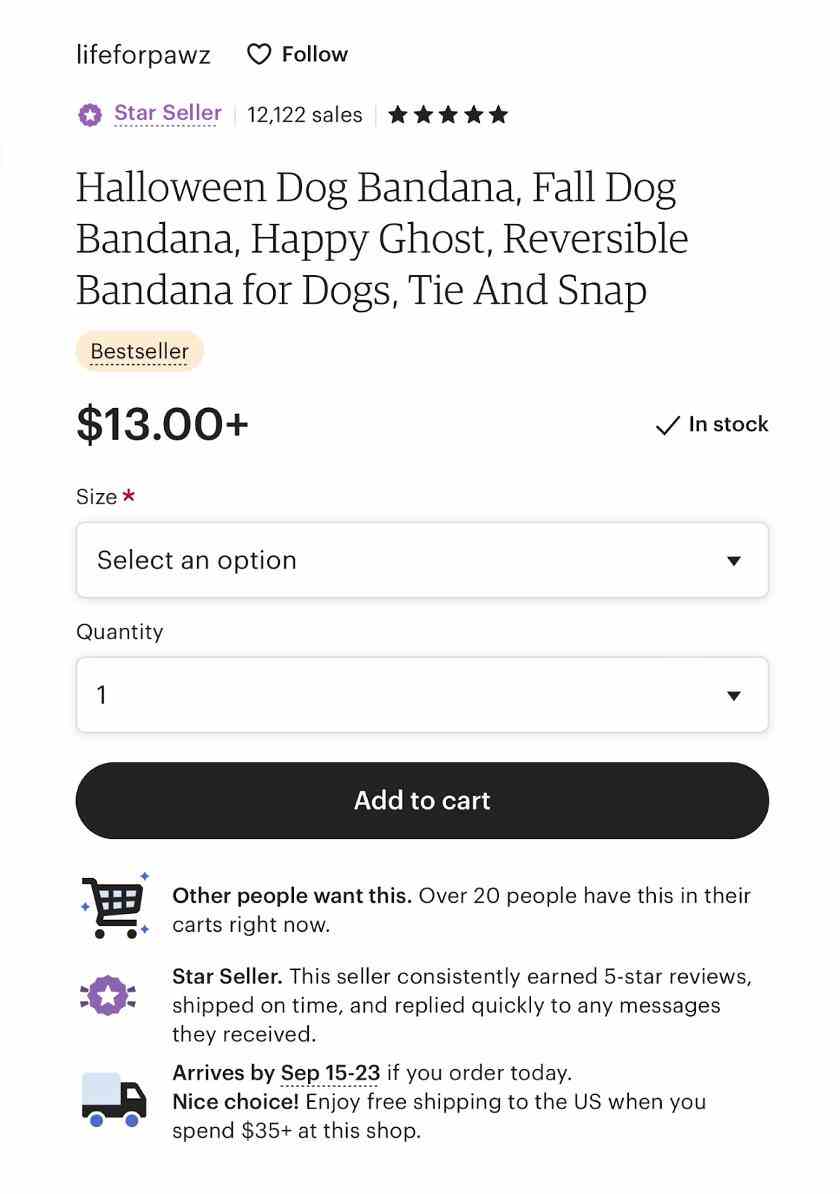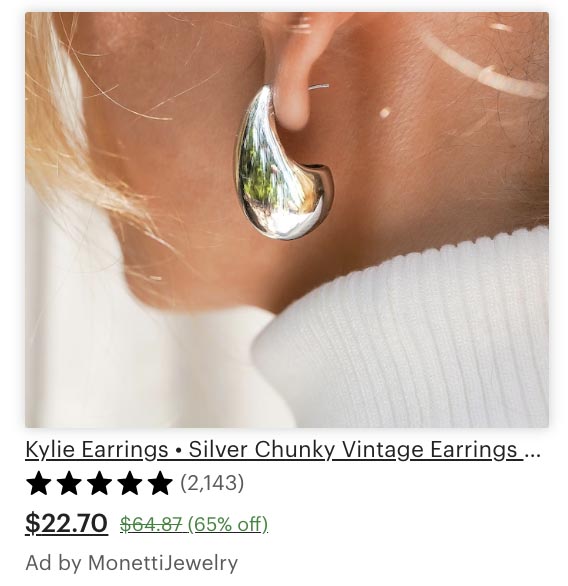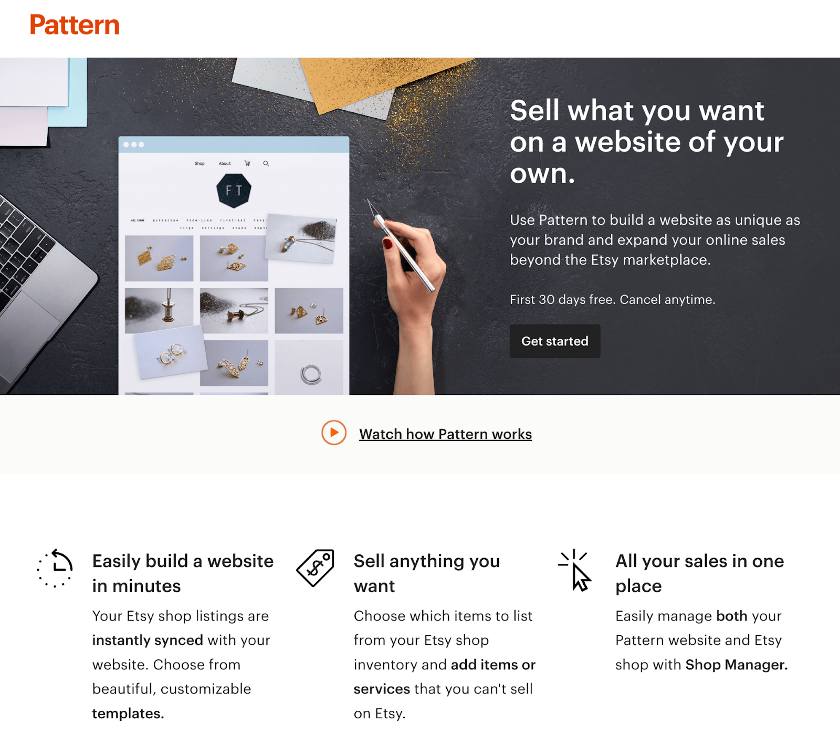While it’s free to set up a seller profile on Etsy, there are fees associated with listing and selling products. The main Etsy seller fees are related to listing items for sale, processing payments, converting currency, advertising and promotions, shipping, and optional add-on services and tools.
Listing fees start at 20 cents per item, and transaction fees are typically 6.5% of the total transaction value. You can upgrade to a $10 monthly subscription for Etsy Plus or $15 to make a customized website through Etsy Pattern. Shipping, taxes, marketing, and advertising costs vary depending on a number of factors.
We’ll walk you through the various Etsy fees below and show you how to estimate how much you’ll pay for each product you sell on the makers’ marketplace.
Etsy Fees Explained
When you start to sell on Etsy, you need to get acquainted with the various Etsy fees you will incur. Here is a breakdown of Etsy seller fees:
On February 21, 2024, Etsy announced it will implement a one-time set-up fee of $15 for new Etsy shops before they can open for business. This fee is non-refundable, paid upfront, and will apply only to new Etsy shops.
Etsy Fee | Cost |
|---|---|
Listing Fees | 20 cents per listing |
Transaction Fees | 6.5% of the total item price, including shipping, gift wrapping, and additional personalization costs |
Etsy Payments Processing Fees | 3% plus 25 cents |
In-person Selling Fees | 20 cents per product (synced or unsynced) plus applicable Square processing fees |
Currency Conversion Fee | 2.5% of item price |
Listing Fees
Merchants pay a 20-cent listing fee for each item they sell from their Etsy storefront. This fee also applies each time you renew a listing. When it comes to private listings, this fee only applies once the item has sold.
After four months from the listing date, the item will expire. If you use the auto-renew feature, your listing will automatically “republish” after the four-month period, and you’ll also pay an additional 20-cent listing fee.
Listing fees appear on your payment account in different ways—but all refer to the “same” listing fee and are all priced at 20 cents:
- Listing fee: The initial fee for listing a new item for sale, valid for four months
- Auto-renew expired: The automatic renewal fee for items unsold after four months (you can disable auto-renewal in the listings settings menu to be able to renew manually)
- Auto-renew sold: The automatic fee for selling extra quantities of items (more than one listed item)
- Multi-quantity: The fee for selling multiple variations of the same item in one payment transaction—for example, if you sell five types of the same item, once one item is sold, another charge will be made for the next item still available, and so on (Etsy doesn’t charge a fee for the extra listings until they sell)
- Private listing: The fee for a private sale to a designated buyer, unlisted to the public—say you arranged a direct sale with a buyer and gave them a direct link to buy, this is still charged a 20-cent listing fee
Note: There is no listing fee if you are only publishing the item for sale to your Etsy Pattern website—we’ll get to that in a bit. Pattern listings don’t expire.
Transaction Fees
Etsy charges a standard transaction fee of 6.5% of the total item price, including shipping, gift wrapping, and additional personalization costs, for every sale you make on your Etsy store. This excludes taxes.
Effective April 11, 2022, Etsy increased its transaction fee from 5% to 6.5%. This prompted many Etsy sellers to go on strike and seek Etsy alternatives. For context, Etsy’s transaction fees are almost double the usual transaction fees of credit card companies and other ecommerce platforms.
For example, let’s say you sell an item with a $15 retail price and $3 shipping. Etsy will charge $0.975 (6.5%) for the listed product price plus $0.195 for the shipping—a total of $1.17 in transaction fees.
NOTE: On your Etsy bill, the transaction fee per product will appear as two different line items: transaction fees deducted from an item price and transaction fees deducted from the item price’s shipping cost.
Etsy Payment Processing Fees
All Etsy sellers are required to use Etsy Payments as their payment provider when selling on the platform. Payment processing fees apply and vary per country. If you’re based in the US, you’ll pay 3% plus 25 cents for every transaction.
In-person Selling Fees
Etsy is compatible with the Square card reader for in-person payment processing. You can integrate Etsy with your Square online store, which will require you to pay the standard 20-cent listing fee for each item. If you don’t sync your products, Etsy will still charge 20 cents in the form of a transaction fee for each sale. There is no 6.5% transaction fee from Etsy for in-person sales made via Square. However, you’ll have to pay Square’s applicable fees.
Currency Conversion Fees
If you list and sell an item for a currency other than your home currency, Etsy Payments will charge a 2.5% currency conversion fee. Etsy mostly does business in US dollars (USD), so if you handle any other type of currency, you may have to pay some sort of currency conversion fee as well. Most merchants will operate with USD, while Etsy uses the euro for merchants and Etsy Payments users in Bulgaria, Croatia, the Czech Republic, Hungary, Poland, and Romania.
Regulatory Operating Fees
Depending on your location, you may also have to pay a Regulatory Operating fee for each transaction. This is applied as a percentage of the total item cost, including shipping, gift wrapping, and personalized customizations. These Etsy seller fees break down as follows:
- United Kingdom: 0.32%
- France: 0.47%
- Italy: 0.32%
- Spain: 0.40%
- Turkey: 1.1%
Shipping Fees
Etsy doesn’t directly offer shipping services and, therefore, doesn’t directly charge shipping fees. Merchants may pay shipping fees to whichever carrier they use, and those fees depend on carrier rates, which often factor in package size, weight, origin destination, and shipping destination.
Additional costs may apply for insurance, signature confirmation, and return labels. You can, however, purchase shipping labels through Etsy—though this requires the use of Etsy Payments or PayPal as a payment method. Again, fees vary.
Etsy currently offers shipping labels through these carriers:
- Australia Post
- Canada Post
- FedEx
- Global Postal Shipping
- USPS
- Royal Mail

As you can see above, this Etsy seller offers free shipping for orders above $35. Most sellers choose to offer free shipping on certain items, for orders over a certain amount, or add on a flat fee.
Etsy Fees Calculation Example
To help you digest all the fees we listed above, we’ll show an example of how these fees add up for an item sold in an Etsy Shop.

(Source: Etsy)
As an example, an Etsy seller based in California sold the item shown above. Shipping fee is at $3, and the buyer used a credit card to pay for the item through Etsy Payments.
Here’s how the listing fees will apply:
Product Price: $22.70
Shipping Cost: $3
Sales Tax: 7.25% x $22.70 = $1.65
Sale Amount: $27.35
Less Fees:
Listing Fee: 20 cents
Transaction Fee: 6.5% x ($22.70+$3)
Sale Amount=Product Price + Shipping
= $1.67
Etsy Payments Fee: 25 cents + 3% x $27.35
Sale Amount
= $1.07
Shipping Etsy Fee: $3 x 5% = 15 cents
Total Etsy Seller Fees: $3.09
Product Price: $22.70
Less Etsy Seller Fees: $3.09
This Etsy seller made $19.61 in net revenue.
To see how Etsy compares with other online selling platforms, take a look at our Shopify vs Etsy comparison guide. Shopify is our top pick for best ecommerce platform, and you can calculate platform fees and processing fees using our Shopify fee calculator.
Etsy Pricing Plans
Etsy lets you sell on its marketplace for free but gives you the option to upgrade to Etsy Plus for $10/month or go with Etsy Pattern at $15/month to build your own store. Note, though, that when you sell on Etsy Pattern, you will not be included in search results from the Etsy marketplace.
Etsy Plus ($10/month)
Etsy Plus is an optional monthly subscription that grants you access to a more comprehensive set of tools to customize and promote your Etsy shop. It costs $10 per month and gives you features including:
- Credits for listings (15/month) and Etsy Ads (worth $5/month)
- 50% discount on a custom web address for your Etsy shop
- Restock requests for shoppers interested in your items that have sold out
- Shop customizations
- Discounts on custom packaging and promotional material like boxes, business cards, and signage
Etsy Plus automatically renews, so you’ll need to proactively cancel if you don’t want to continue paying the $10 monthly fee.
Etsy Pattern ($15/month)
Etsy Pattern is an optional add-on that allows you to create a fully customized Etsy website, designed and branded to your liking. This requires a $15 monthly subscription fee (plus any applicable sales tax), though Etsy offers the first 30 days free as a trial. You may also have to pay domain name registration fees. Etsy Pattern subscriptions automatically renew, so you’ll need to proactively cancel if you don’t want to use or pay for this tool.

Etsy Pattern is a site builder that is optional for Etsy sellers.
Etsy Advertising & Promotional Fees (Optional)
Etsy has additional optional services to promote your storefront as part of your retail marketing strategy. These services come with additional Etsy seller fees.
Etsy Ads
Etsy Ads increase the visibility of your store and products for Etsy’s on-site search and related pages. The fees for Etsy Ads vary depending on your budget and goals—you can spend as much as your marketing and advertising budget allows. You can set your own maximum daily budget, and Etsy will advertise until you hit that budget. Etsy defaults to a $25 max daily budget, but you can adjust this as needed.

Similar to Amazon or Google Ads, Etsy Ads help your products appear in search results for specific keywords.
Off-site Ads
Etsy’s off-site ads increase your visibility on external sites and platforms in its network of advertising partners, which may include social media, search engines, and other places on the web consumers shop. These fees are 15% of Attributed Orders for the previous year. Attributed Orders come from people who click on the ad and make a purchase from your Etsy store within 30 days of that interaction. Once you exceed $10,000 in annual sales, this fee drops to 12%.
Etsy Sales Taxes
All online merchants are responsible for staying up-to-date with the latest ecommerce sales tax requirements and regulations, both in the locations they’re operating from and the locations they’re shipping to. You can adjust sales tax settings from your Shop Manager dashboard.
Etsy automatically prepares and supplies US-based sellers with an annual 1099-K form for their federal and state taxes. Sellers doing business in other countries may need to accommodate VAT or GST, depending on their location. Sometimes, Etsy will automatically calculate and collect this on your behalf. Other times, you’ll need to customize pricing and tax settings to ensure you’re compliant.
Etsy may also charge sales tax on additional services like Etsy Plus, Etsy Pattern, and seller fees.
How to Pay Etsy Fees
Etsy automatically deducts seller fees from your Etsy balance if you are using Etsy Payments, so when Etsy sends you a deposit, all the fees have already been taken out and paid for.
Etsy fees for a given month can be paid from the first day of the following month. You can pay your amount due between the first and 15th of the month. You can pay with a debit card, a credit card, a prepaid card, or PayPal from your Etsy dashboard.
How to Save on Etsy Fees
As you can probably surmise, Etsy fees can add up quickly, and if you are not careful in accounting for these fees, you can end up with a very slim profit margin or even a profit loss. We list some tips on how to minimize costs to sell on Etsy.
Set Product Prices in Your Bank Account’s Currency
Skip Etsy’s 2.5% currency conversion fee by using the same currency in your bank account for your product listings.
Increase Your Prices
This is the easiest way to protect your profit margins. If you have consistent sales on a particular item, don’t be afraid to increase your prices to reflect the demand for the product (remember you are selling handmade products so it is more valuable, in terms of cost and time). Of course, this is also a risk because you might alienate potential and existing customers. Just remember to keep your prices within the range of your competition.
Related:
Do Product Bundles
A workaround to avoid several product listing fees is to bundle your items together. If they are related and can be sold as such, consider bundling items so it only incurs one listing fee. Don’t limit bundling to related items; you can bundle similar items. For example, you sell handmade candles. You can sell three candles as a bundle and it costs you a 20-cent listing fee, instead of the 60-cent fee to individually list three candles.
Do Marketing Before Paid Advertising
Etsy ads don’t guarantee sales; they just list your product higher in the search results. When you decide to invest in ads, ensure your listing is optimized with good product photos and trending keywords to help ensure your ad will convert to a sale.
Consider doing aggressive and consistent marketing first, using the tips we list in our articles below:
- Retail Marketing Strategy Ideas to Drive Sales
- Ecommerce Marketing Strategy Ideas for Retailers
- Tips for Selling on Etsy Successfully
Get Your Own Online Store
If Etsy’s fees feel too much for you, it’s time to consider opening your own online store. It will take a bit more effort and time to set up, plus you will shell out more in startup fees. However, the initial time and costs spent during the launch of your online store will help you save more in the long run. Alternatively, consider free website builders if you are really on a budget.
Explore other online store platforms by going through the following guides:
- Best Ecommerce Platforms for Small Businesses
- Best Free Ecommerce Website Builders
- Shopify vs Etsy Comparison: Which Is Best for Your Business?
- Big Cartel vs Etsy: Price, Features & What’s Best in 2023
- Best Etsy Alternatives
Bottom Line
Around 6.3 million sellers actively make profits on Etsy’s marketplace to a customer base of over 90 million consumers. As many as 71% of Etsy sellers view their shop as a legitimate business, and 82% have aspirations to grow sales. With so much opportunity for growth, it’s important to be aware of associated fees so you can factor this into your pricing strategy and ensure profitability.
Etsy can change these fees at any moment, too. So, it’s vital to understand the fees and costs you incur, as well as ways to lower those fees or take advantage of other selling channels. With this knowledge in mind, you’ll be able to successfully sell profitable products in this ever-growing creative marketplace.